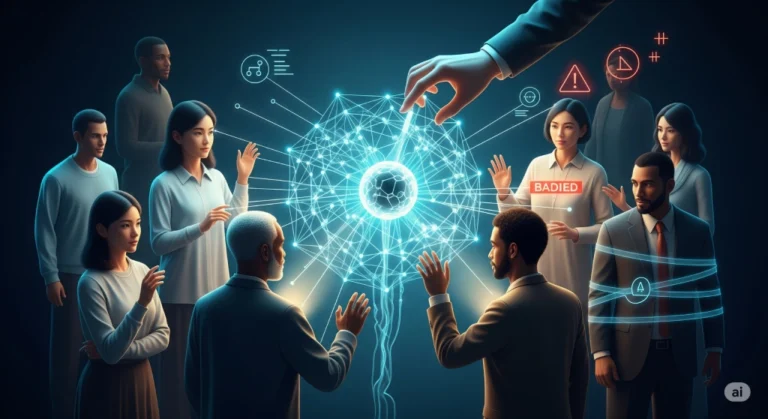Artificial Intelligence is rapidly transforming our world, from the way we get news and loan approvals to how medical diagnoses are made. We often perceive AI as objective and data-driven, a purely logical force. But what if this powerful technology inherits our own human flaws? The uncomfortable truth is that AI bias is real, and its subtle yet significant influence is shaping decisions that affect us all – often without us even realizing it.
This isn’t just a technical problem for data scientists; it’s a societal issue that demands everyone’s attention. Understanding AI bias, knowing how to spot it, and recognizing why it matters is crucial for navigating our increasingly AI-driven future fairly and equitably.
What Exactly Is AI Bias?
At its core, AI bias refers to situations where an AI system produces outputs that are systematically prejudiced due to erroneous assumptions in the machine learning process. Think of it like this: AI systems learn from the data they are fed. If that data reflects existing societal biases (related to race, gender, age, socioeconomic status, etc.), the AI will learn and perpetuate – sometimes even amplify – those biases.
Bias can creep in at various stages:
- Data Collection: The data used to train AI might overrepresent certain groups and underrepresent others.
- Algorithm Design: The choices made by developers when creating the algorithm can inadvertently introduce bias.
- Human Interpretation & Interaction: How humans label data or interact with AI outputs can also reinforce biases.
How to Spot AI Bias: Red Flags and Real-World Examples
Identifying AI bias can be tricky because it often operates beneath the surface. However, here are some common indicators and well-known examples:
- Disproportionate Outcomes for Different Groups:
- Example: Facial recognition software historically performing less accurately on individuals with darker skin tones or on women. This can lead to misidentification with serious consequences in law enforcement or security.
- How to Spot: Look for patterns where an AI system consistently favors or disadvantages a particular demographic in its decisions or predictions.
- Reinforcement of Harmful Stereotypes:
- Example: AI-powered recruitment tools that were found to penalize resumes containing the word “women’s” (e.g., “women’s chess club captain”) or that favored candidates with names more common among certain ethnic groups because historical hiring data reflected such biases.
- How to Spot: Notice if AI outputs tend to associate certain characteristics, roles, or behaviors predominantly with specific groups, mirroring societal stereotypes.
- Unfair or Inequitable Resource Allocation:
- Example: AI systems used in loan applications or credit scoring that disproportionately deny qualified applicants from minority communities due to biased historical lending data.
- Example: Healthcare algorithms that underestimate the health risks of Black patients because historical data reflected unequal access to care, leading to them being recommended for less intensive treatment.
- How to Spot: Investigate whether AI-driven decisions about who gets access to opportunities, services, or resources seem skewed along demographic lines, even when other factors should be equal.
- Lack of Transparency (The “Black Box” Problem):
- Example: An AI makes a critical decision (e.g., parole denial), but it’s impossible to understand the specific factors that led to that outcome. This lack of explainability can make it very difficult to identify or challenge bias.
- How to Spot: Be wary of AI systems whose decision-making processes are entirely opaque. Demand for “explainable AI” (XAI) is growing to combat this.
- Over-reliance on Flawed or Incomplete Data:
- Example: Predictive policing models trained primarily on historical arrest data from over-policed neighborhoods might lead to increased surveillance and arrests in those same areas, creating a feedback loop that reinforces existing biases rather than reflecting actual crime rates.
- How to Spot: Question the source and completeness of the data an AI system is trained on. Is it truly representative of the entire population it will affect?
Why AI Bias Matters to Everyone
The consequences of AI bias are far-reaching and can impact nearly every facet of our lives:
- Erosion of Trust: If AI systems are perceived as unfair or discriminatory, public trust in technology and the institutions that deploy it will diminish.
- Reinforcing Inequality: AI bias can perpetuate and even worsen existing social, economic, and racial inequalities, making it harder to achieve a just society.
- Missed Opportunities: Biased AI can lead to qualified individuals being overlooked for jobs, loans, education, or other opportunities, stifling talent and innovation.
- Harm and Discrimination: In critical areas like healthcare, criminal justice, and finance, biased AI can lead to tangible harm, wrongful arrests, inadequate medical care, or financial exclusion.
- Impact on Democracy: Biased algorithms in social media feeds or news aggregation can shape public opinion, spread misinformation, and influence electoral processes in unfair ways.
- Economic Consequences: Companies deploying biased AI can face reputational damage, legal challenges, and loss of customer trust, impacting their bottom line.
The Path Forward: Addressing and Mitigating AI Bias
While the challenge of AI bias is significant, it’s not insurmountable. Efforts are underway to address it:
- Diverse and Representative Data Sets: Ensuring training data accurately reflects the diversity of the population.
- Algorithmic Fairness Audits: Regularly testing AI systems for biased outcomes.
- Developing Explainable AI (XAI): Making AI decision-making processes more transparent and understandable.
- Diverse Development Teams: Including people from various backgrounds in the design and development of AI systems.
- Ethical Guidelines and Regulation: Establishing clear ethical frameworks and legal standards for AI development and deployment.
- Public Awareness and Literacy: Educating the public about AI bias so they can identify and challenge it.
Conclusion: Our Collective Responsibility
AI bias isn’t a futuristic concern; it’s a present-day reality with profound implications. Recognizing that AI systems are built by humans and learn from human-generated data is the first step. By understanding how to spot AI bias and appreciating its widespread impact, we can all contribute to advocating for and building artificial intelligence that is fair, equitable, and truly serves humanity. The future of AI depends not just on technological advancement, but on our collective commitment to ethical development and responsible implementation.


